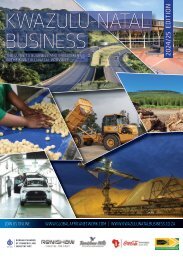South African Business 2018 edition
Welcome to the sixth edition of the South African Business journal. First published in 2011, the publication has established itself as the premier business and investment guide to South Africa, supported by an e-book edition at www.southafricanbusiness.co.za. Regular pages cover all the main economic sectors of the South African economy and give a snapshot of each of the country’s provincial economies. Feature articles on topical issues such as sustainability and African trade provide unique insights, together with an interview with the newly elected chairman of the African Association of Automotive Manufacturers, Mr Thomas Schaefer. Another special feature focusses on an exciting project to transform South Africa’s small harbours and coastal properties. South African Business is complemented by nine regional publications covering the business and investment environment in each of South Africa’s provinces. The e-book editions can be viewed online at www.globalafricanetwork.com. First published in 2011, the publication has established itself as the premier business and investment guide to South Africa, supported by an e-book edition at www.southafricanbusiness.co.za Regular pages cover all the main economic sectors of the South African economy and give a snapshot of each of the country’s provincial economies. Feature articles on topical issues such as sustainability and African trade provide unique insights, together with an interview with the newly elected chairman of the African Association of Automotive Manufacturers, Mr Thomas Schaefer. Another special feature focusses on an exciting project to transform South Africa’s small harbours and coastal properties. South African Business is complemented by nine regional publications covering the business and investment environment in each of South Africa’s provinces. Visit www.globalafricanetwork.com for more business and investment news, opportunities and events.
Welcome to the sixth edition of the South African Business journal. First published in 2011, the publication has established itself as the premier business and investment guide to South Africa, supported by an e-book edition at www.southafricanbusiness.co.za.
Regular pages cover all the main economic sectors of the South African economy and give a snapshot of each of the country’s provincial economies. Feature articles on topical issues such as sustainability and African trade provide unique insights, together with an interview with the newly elected chairman of the African Association of Automotive Manufacturers, Mr Thomas Schaefer. Another special feature focusses on an exciting project to transform South Africa’s small harbours and coastal properties.
South African Business is complemented by nine regional publications covering the business and investment environment in each of South Africa’s provinces. The e-book editions can be viewed online at www.globalafricanetwork.com.
First published in 2011, the publication has established itself as the premier business and investment guide to South Africa, supported by an e-book edition at www.southafricanbusiness.co.za
Regular pages cover all the main economic sectors of the South African economy and give a snapshot of each of the country’s provincial economies. Feature articles on topical issues such as sustainability and African trade provide unique insights, together with an interview with the newly elected chairman of the African Association of Automotive Manufacturers, Mr Thomas Schaefer. Another special feature focusses on an exciting project to transform South Africa’s small harbours and coastal properties.
South African Business is complemented by nine regional publications covering the business and investment environment in each of South Africa’s provinces. Visit www.globalafricanetwork.com for more business and investment news, opportunities and events.
Create successful ePaper yourself
Turn your PDF publications into a flip-book with our unique Google optimized e-Paper software.
SPECIAL FEATURE<br />
Fully 30% of <strong>South</strong> Africa’s<br />
exports are to other countries in<br />
Africa, but a massive 83% of this<br />
volume is into <strong>South</strong>ern Africa.<br />
This means that the potential<br />
for <strong>South</strong> Africa to grow its exports<br />
into other parts of Africa is<br />
enormous.<br />
The Export Credit Insurance<br />
Corporation of <strong>South</strong> Africa<br />
(ECIC) exists to help trade and<br />
investment across borders. ECIC<br />
provides insurance for bank loans<br />
that are taken by investors and<br />
<strong>South</strong> <strong>African</strong>s can get insurance<br />
for investments, and for small and<br />
medium enterprises there is a<br />
product available (performance<br />
bonds) to anyone exporting<br />
capital goods and services.<br />
The <strong>South</strong> <strong>African</strong> Department<br />
of Trade and Industry (dti) plays a<br />
key role in promoting trade between<br />
<strong>South</strong> Africa and the rest<br />
of Africa. <strong>South</strong> <strong>African</strong> exporters<br />
can enroll in the dti’s training<br />
programme, Global Export Passport Programme<br />
(GEPP). The dti wants to expand <strong>South</strong> <strong>African</strong> exports<br />
in manufacturing (which it wants to double<br />
in 10 years) and services (40% of the export basket<br />
by 2030).<br />
The Integrated National Export Strategy (INES)<br />
is managed by a unit called Trade and Investment<br />
<strong>South</strong> Africa (Tisa), which is targeting emerging<br />
markets, including the BRIC states (Brazil, Russia,<br />
India and China).<br />
Connecting<br />
Intra-<strong>African</strong> trade currently stands at 16% of trade<br />
volumes. This is in contrast to the continent of<br />
Europe, where 60% of all trade is conducted among<br />
European nations, and in Asia, where the figure<br />
is 40%.<br />
Border delays, tariffs and infrastructure are the<br />
biggest barriers to expanding this trade. Shoprite<br />
spends about R20 000 per week in permits, and long<br />
waits at border posts are routine. The revamped<br />
Chirundu one-stop border post in Zambia has<br />
reduced transit times by a third.<br />
There are plans to create a Tripartite Free Trade<br />
Area covering three regional groupings across<br />
26 countries. Extending from <strong>South</strong> Africa in the<br />
south to Uganda and Kenya in the north, the proposed<br />
free trade area would encompass more<br />
than 620-million consumers in three regional<br />
organisations: the <strong>South</strong>ern <strong>African</strong> Development<br />
Community (SADC), the Common Market for East<br />
and <strong>South</strong>ern Africa (Comesa) and the East <strong>African</strong><br />
Community (EAC).<br />
The Sustainable Development Investment<br />
Partnership (SDIP) comprises 30 institutions and<br />
aims to fund 16 <strong>African</strong> infrastructure projects, valued<br />
at more than $20-billion. The founders of the<br />
SDIP were the World Economic Forum (WEF) and<br />
the Organisation for Economic Co-operation and<br />
Development (OECD).<br />
China has pledged to support the rehabilitation<br />
of the railway line between Zambia and Tanzania<br />
while the Industrial and Commercial Bank of China<br />
is to invest R20-billion in renewable energy in Africa.<br />
Railway upgrades will probably reap the quickest<br />
rewards in the push to promote intra-<strong>African</strong><br />
trade. Fully 70% of the freight that arrives in <strong>South</strong><br />
Africa is delivered by road: this is both a problem<br />
and an opportunity. One of the companies<br />
eyeing that opportunity is <strong>South</strong> <strong>African</strong> rail operator<br />
Sheltam Group. It has created a rail track<br />
infrastructure funding vehicle with a dedicated<br />
<strong>African</strong> mandate.<br />
The Development Bank of <strong>South</strong>ern Africa and<br />
Transnet have developed a financing scheme for<br />
selected buyers of rail rolling stock and port equipment.<br />
Transnet is already very active in <strong>African</strong><br />
countries north of the <strong>South</strong> <strong>African</strong> border.<br />
This is part of Transnet’s Market Demand Strategy<br />
(MDS), which aims to sell it products and services<br />
around the world. Transnet Engineering’s Trans-<br />
Africa Locomotive (for branch lines and shunting<br />
yards) is being marketed to other <strong>African</strong> countries<br />
and mining companies. Transnet Engineering plans<br />
is establishing Maintenance Repair and Operations<br />
centres in four <strong>African</strong> countries.<br />
23 SOUTH AFRICAN BUSINESS <strong>2018</strong>


















